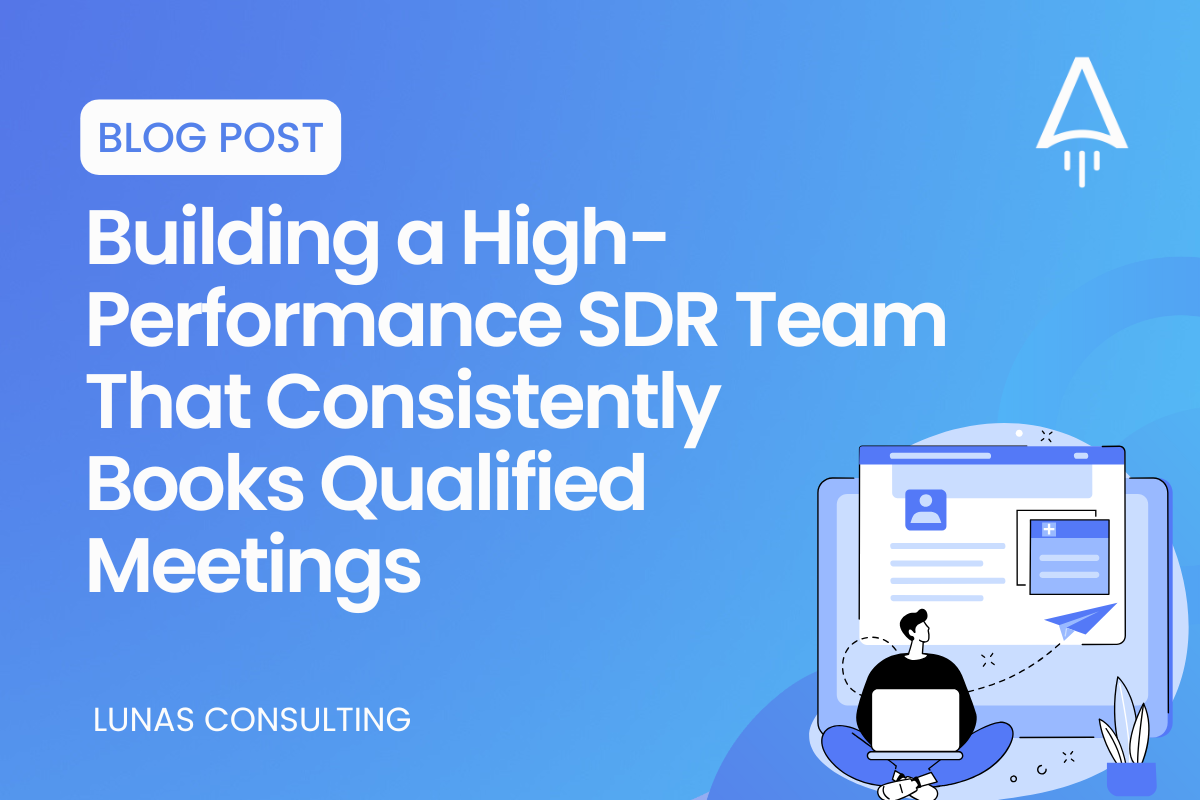Building a High-Performance SDR Team That Consistently Books Qualified Meetings
Discover proven strategies for hiring, training, performance optimization, and scaling that top-performing teams use to book 3x more qualified meetings.
Discover proven strategies for hiring, training, performance optimization, and scaling that top-performing teams use to book 3x more qualified meetings.

Top-performing SDR teams book significantly more qualified meetings than average teams, yet most companies struggle with SDR productivity. The difference between mediocre and exceptional sales development isn't just about working harder. It's about building the right foundation, hiring strategically, and implementing systems that scale.
Building and managing an effective outbound sales development team has become increasingly complex. The modern SDR faces more sophisticated buyers, heightened competition for attention, and evolving technology landscapes. But here's where it gets interesting: companies that master the SDR function see dramatically higher win rates and faster revenue growth.
We’ve put together a 4-part framework for SDR success. From strategic foundation and team structure through hiring, training, and performance optimization, these strategies transform average teams into revenue-generating powerhouses. Let's break down exactly how top performers achieve these results.
The sales development representative role has undergone dramatic transformation over the past decade. What once involved simple cold calling has evolved into a sophisticated, multi-channel orchestration requiring technical skills, business acumen, and strategic thinking.
Today's SDRs navigate complex buying committees, leverage advanced sales intelligence tools, and execute personalized outreach at scale. They're not just appointment setters; they're the architects of pipeline generation. Research shows that 70% of companies expect to add more SDRs to their team in the next year, demonstrating the growing importance of this function.

Key performance indicators have shifted from pure activity metrics to quality-focused outcomes. While dial counts still matter, meeting quality, prospect engagement depth, and revenue influence carry greater weight. Modern SDRs are measured on their ability to identify ideal customer profile matches, uncover genuine business pain, and create meaningful connections that convert to opportunities. The big question is: how do organizations build teams capable of delivering these sophisticated outcomes?
Common misconceptions about SDR functions often limit team potential. Many companies still view SDRs as junior roles requiring minimal training or investment. This outdated perspective leads to annual turnover rates averaging above 30%, with some companies experiencing rates above 55%. The reality? Top-performing SDR teams require the same strategic attention as any revenue-critical function.
You may also be interested in: Transforming Cold Leads into Sales Opportunities Through Strategic Sequence Design
Choosing the right SDR team model determines long-term success potential. The decision between specialized versus generalized roles impacts everything from hiring profiles to training requirements. Here's the problem: most companies default to a one-size-fits-all approach. But market dynamics, product complexity, and buyer personas demand customized structures.
The two paths here are clear. Path one involves maintaining generalist SDRs who handle both inbound and outbound activities. Path two creates specialized roles focused on specific channels or market segments. Each approach has merit depending on your situation.
Inbound versus outbound specialization represents the most common division. Inbound SDRs capitalize on marketing-generated interest, with conversion rates varying from 5-10% for low-intent leads to 75-80% for high-intent leads like demo requests. Outbound SDRs proactively hunt for new opportunities, demanding stronger research capabilities and persistence. Account-based SDR strategies take specialization further, dedicating resources to high-value target accounts with coordinated multi-touch campaigns.
Territory and market segmentation adds another layer of optimization. Geographic territories work well for localized products, while vertical specialization excels in complex industries. Team size considerations depend on market opportunity, average deal size, and sales cycle length. The average ratio is 2.6 AEs for every 1 SDR, though higher growth companies may experience tighter ratios.
A tip from us: Start with outcome-based KPIs and work backward to activity metrics. This ensures every activity directly contributes to revenue goals rather than creating busy work.
The debate between activity-based and outcome-based KPIs misses the point entirely. Both matter, but the relationship between them determines success. Leading indicators like call volume and email sends predict future performance. Lagging indicators like meetings booked and pipeline generated measure actual impact. The key lies in understanding the correlation between activities and outcomes for your specific market.
Meeting quality measurement frameworks prevent the common trap of quantity over quality. Consider implementing these essential components:
The Bridge Group found that the median pipeline generated per SDR is $3 million per year, though there's wide variation across companies. Revenue influence attribution, though complex, provides the ultimate performance validation. Modern attribution models track SDR-sourced and SDR-influenced deals, capturing full contribution value.
The difference between average and exceptional SDRs isn't always obvious in resumes. Top performers share specific traits that predict success regardless of industry or product. Essential skills divide into two categories: teachable and inherent.
Teachable skills include product knowledge, sales methodology, and tool proficiency. These develop through training and experience. Inherent traits like curiosity, resilience, and coachability determine growth potential. But what happens when you need to evaluate these intangible qualities?

Structured behavioral assessments reveal true capabilities. Look for evidence of persistence through rejection, ability to learn from failure, and genuine interest in problem-solving. Previous success in competitive environments, whether sales, sports, or academics, often translates well. The sweet spot for experience often involves hiring those with 6-18 months of SDR experience, combining foundational knowledge with continued growth potential.
You may also be interested in: Understanding Sales Sequences and Marketing Automation for Maximum Lead Conversion
Sourcing the right candidates requires thinking beyond traditional job boards. The best SDR talent often isn't actively looking, making proactive recruitment essential. Multi-channel sourcing yields the highest quality candidate pools through various approaches:
Interview process design should mirror the actual SDR role. Include role-playing exercises, writing samples, and live cold calling scenarios. Evaluate how candidates handle rejection, think on their feet, and communicate value propositions. The most predictive interviews simulate real job challenges rather than relying solely on hypothetical questions.
Various job listing sites show that the average sales development representative salary ranges from $48,973 to $66,577, though this often doesn't include commission or bonuses. Compensation structure typically involves a 60-70% base salary and 30-40% variable compensation split. Clear career progression paths with transparent promotion criteria attract ambitious candidates seeking growth opportunities.
The average SDR ramp time is 3.1-3.2 months. Here's where it gets interesting: most companies throw new SDRs into the deep end with minimal preparation. This sink-or-swim approach leads to early burnout and turnover. Instead, progressive skill building creates confidence and competence simultaneously.
Week one focuses on company overview, industry positioning, mindset training, and sales methodology fundamentals. New hires absorb the company story, understand the mission, and learn why customers choose your solution. Weeks two and three dive deep into buyer personas, value propositions, and practical application. SDRs practice identifying pain points, crafting messaging, and handling common scenarios. Week four introduces live prospecting with close supervision, allowing safe practice with real prospects.
Product and market training must balance depth with practicality. SDRs need enough knowledge to have credible conversations without becoming product experts. Focus on understanding customer pain points, competitive differentiators, and common objections. Use case studies and win stories to illustrate successful applications. Regular "voice of customer" sessions with existing clients provide authentic insights that training materials can't replicate.
Mentorship programs accelerate learning through peer modeling. Pair new SDRs with top performers for shadowing opportunities, and implement buddy systems where recent graduates guide newcomers through early challenges. This approach provides safe spaces for questions while building team cohesion.
Building exceptional SDR skills requires systematic development across multiple competencies. The foundation starts with mastering prospecting and research techniques that identify high-potential targets efficiently.
Modern prospecting goes far beyond list building. SDRs must understand ideal customer profiles deeply, recognizing buying signals and trigger events that indicate readiness. They need to navigate complex organizational structures, identifying decision makers, influencers, and champions. Training should focus on teaching SDRs to recognize patterns like funding announcements, leadership changes, or technology adoptions that create sales opportunities.

Outreach message crafting has become both art and science. The days of generic templates achieving results have passed. Today's buyers expect personalized, relevant communications that demonstrate understanding of their specific challenges. Training must cover value-based messaging, social proof integration, and multi-touch sequence design. SDRs learn to write compelling subject lines, opening lines that grab attention, and calls-to-action that drive response.
But here's the problem: even perfect messages fail without strong objection handling. Common objections stop most SDRs cold. Effective training provides frameworks for reframing objections as opportunities for deeper discovery. Role-playing exercises build muscle memory for smooth responses. The goal isn't memorizing scripts but understanding the psychology behind objections and addressing underlying concerns.
A tip from us: Master one channel thoroughly before adding others. SDRs who excel at phone prospecting before adding email and social typically achieve better overall results than those trying to master everything simultaneously.
The modern buyer journey spans multiple channels, requiring SDRs to orchestrate coordinated campaigns across phone, email, LinkedIn, and emerging platforms. Each channel demands unique skills and strategies while maintaining consistent messaging.
It takes an average of 8 cold call attempts to reach a prospect, making phone prospecting skills critical. Training must address both technical skills and psychological barriers. Key phone skills include:
Email sequences require different muscles entirely. Subject line testing, preview text optimization, and message personalization at scale challenge even experienced SDRs. The key lies in balancing automation with authenticity. Templates provide structure, but customization creates connection.
LinkedIn outreach strategies continue evolving as the platform adjusts its policies. Connection request acceptance rates have declined significantly, making message quality critical. SDRs must build genuine professional brands, share valuable content, and engage authentically before pitching. Video messages create pattern interrupts that can achieve response rates of 37.5% and positive response rates of 12.75%, but require confidence and practice to execute effectively.
The difference between average and exceptional SDR performance often comes down to daily execution discipline. Time management separates those who consistently hit targets from those who struggle despite working hard.
Activity planning starts with understanding your numbers. If the average SDR books around 15 meetings per month, daily activities must align accordingly. But raw activity isn't enough. Strategic prioritization ensures high-value accounts receive appropriate attention. The "power hour" concept dedicates peak energy times to highest-impact activities like calling while relegating administrative tasks to lower-energy periods.
Pipeline management requires constant attention to prevent deals from stalling. SDRs must track prospect engagement, follow up systematically, and recognize buying signals that warrant immediate action. CRM hygiene seems mundane but determines data quality for entire organizations. Training SDRs on proper data entry, consistent naming conventions, and detailed activity logging pays dividends downstream.
The bottom line? Daily discipline compounds into exceptional results. Top performers don't work significantly more hours; they work more strategically. They batch similar activities, minimize context switching, and protect prospecting time religiously.
Real-time performance visibility transforms coaching from reactive to proactive. Modern sales engagement platforms provide unprecedented insight into SDR activities and outcomes, enabling targeted intervention before problems escalate.

Performance dashboards should balance leading and lagging indicators. Display daily activities alongside weekly meetings booked and monthly pipeline generated. Include conversion rates at each stage to identify bottleneck areas. Make these visible to entire teams, creating natural accountability and healthy competition.
One-on-one coaching frameworks provide structured development opportunities. Weekly sessions review performance metrics, analyze specific calls or emails, and practice skill development. The most effective coaches ask questions rather than providing answers, building critical thinking skills that extend beyond specific situations. They spend majority time on skill coaching, followed by deal strategy, with minimal time on administrative items.
Call and email monitoring reveals coaching opportunities invisible in metrics alone. Listen for missed qualification questions, weak value propositions, or poor objection handling. Review email templates for clarity, compelling language, and appropriate personalization. Provide specific, actionable feedback tied to business outcomes.
You may also be interested in: Converting MQLs into SQLs Through Strategic Nurture Sequences
Testing and optimization separate good SDR teams from great ones. Every outreach campaign provides learning opportunities that inform future strategies. But what happens when traditional tactics stop working?
A/B testing frameworks for outreach should examine single variables systematically. Test subject lines while keeping email bodies constant. Compare call opening statements with identical talk tracks afterward. This scientific approach reveals what truly drives response rates versus assumptions. Document results meticulously, building playbooks of proven approaches.
Conversion funnel analysis identifies improvement opportunities at each stage. Regular examination reveals where prospects drop off, which objections appear repeatedly, and what messages resonate most strongly. SDRs should track metrics like lead-to-opportunity conversion rates, meetings booked, and lead qualification rates to identify areas for improvement.
Market dynamics, competitor actions, and buyer behavior changes require constant adaptation. Regular win-loss analysis with AEs provides feedback on meeting quality. Survey prospects who didn't convert to understand why. This outside-in perspective prevents echo chamber thinking that limits growth.
Scaling SDR teams requires careful timing and execution. Premature scaling wastes resources while delayed scaling misses market opportunities. Growth timing indicators extend beyond simple capacity constraints.
Look for consistent achievement of team quotas, stable conversion rates, and proven playbooks that new hires can follow. Market signals like increased inbound interest, expanding territories, or new product launches justify expansion. The key question becomes: can current systems and leadership support additional headcount effectively?
Hiring velocity must balance growth needs with training capacity. Consider these scaling principles:
Leadership structure development becomes critical at specific team sizes. Teams of 5-8 SDRs typically need dedicated management. Beyond that, consider team lead roles for senior SDRs. This creates career progression opportunities while maintaining appropriate supervision ratios.
Every SDR team faces predictable challenges. Understanding these patterns enables proactive solutions rather than reactive firefighting.
Addressing low performance requires systematic diagnosis before intervention. The correlation between lower attrition rates and higher percentage of reps meeting quotas suggests that retention and performance are closely linked. Start with data analysis to identify specific failure points. Low activity might indicate motivation issues or tool problems. Poor conversion could suggest skill gaps or market misalignment.

The average SDR tenure is just 1.5-1.8 years, but top companies achieve longer retention through intentional strategies. The Bridge Group Report finds that proper training and development offered by the employer will keep 86% of millennials from leaving their current position. Career development conversations should begin during onboarding, outlining clear progression paths. Regular recognition, both public and private, maintains motivation during rejection-heavy periods.
Quality maintenance during growth challenges even successful teams. New hires dilute team averages temporarily. Experienced SDRs may resist process changes. Culture can shift from collaborative to competitive. Combat these issues through documented standards, peer mentorship programs, and cultural reinforcement activities.
The true measure of SDR team success extends beyond monthly quotas. Long-term value creation requires comprehensive measurement frameworks that capture full business impact.
Key performance indicators should ladder up to company objectives. On average, 1 in 2 meetings generated by an SDR will lead to a next step in the sales process, meaning an SDR producing 12 attended meetings monthly could generate $600,000 in pipeline value. Track both SDR-sourced and SDR-influenced opportunities to capture complete contribution.
ROI calculation justifies continued investment and expansion. Research from DePaul University concluded that it costs almost $100k to replace an SDR, including training, acquisition, and missed quotas. Calculate fully-loaded cost per meeting, including salaries, benefits, tools, and management overhead. Compare against customer acquisition costs from other channels.
Here's where it gets interesting: the best SDR teams contribute beyond pipeline generation. They provide market intelligence about competitor movements, customer pain points, and messaging effectiveness. They test new value propositions and identify expansion opportunities within existing accounts. This strategic value, while harder to quantify, often exceeds direct revenue contribution.
You may also be interested in: Multi-Channel Sales Sequences That Transform B2B Lead Generation Results
Building and managing high-performing SDR teams requires systematic approaches across four critical areas. Strategic foundation and team structure create the framework for success. Thoughtful hiring and comprehensive onboarding build strong talent pipelines. Continuous training and skill development maintain competitive advantages. Performance management and optimization drive consistent results while scaling sustainably.
The path forward starts with honest assessment of current capabilities against this framework. Identify the biggest gaps impacting performance and address them sequentially. Perfect execution in one area beats mediocre attempts across all four. Most importantly, remember that SDR team building is an iterative process requiring constant refinement.

Transform your SDR team from cost center to revenue engine by implementing these proven strategies. Start with foundational elements, measure relentlessly, and optimize continuously. The companies winning in today's competitive landscape have mastered this formula. Now it's your turn to build the SDR team that drives exceptional growth.
Interested in improving your skills and learning more about business operations to generate and convert leads? Check out the following articles:
Essential Online Presence Tools Every Business Owner Should Use in 2025
Why Small Businesses Need a Strong Online Presence to Survive and Thrive
How Your Online Presence Functions as Your Most Powerful Business Card
Building a Loyal Online Following Through Strategic Social Media Consistency
How Social Media Transforms Your Digital Strategy and Online Business Growth
10 Time-Saving Strategies for Effective Business Updates Across Social Media Platforms
We have a lot more for you. Click the button below to sign up and get notified when we release more content!
View more